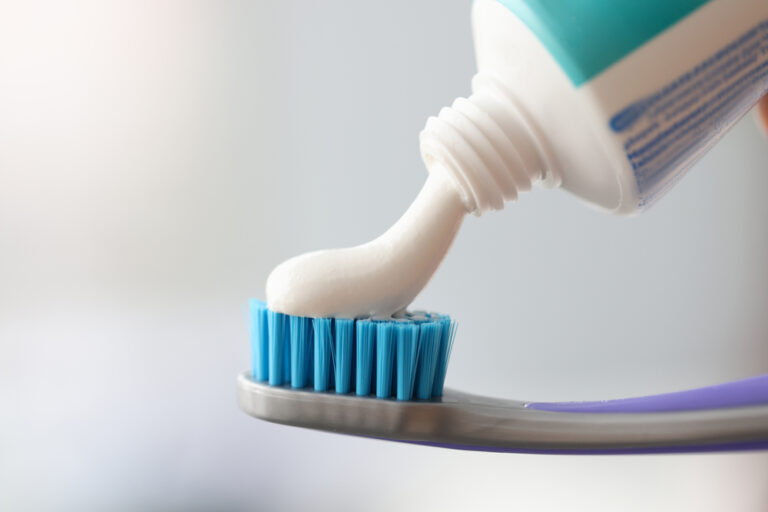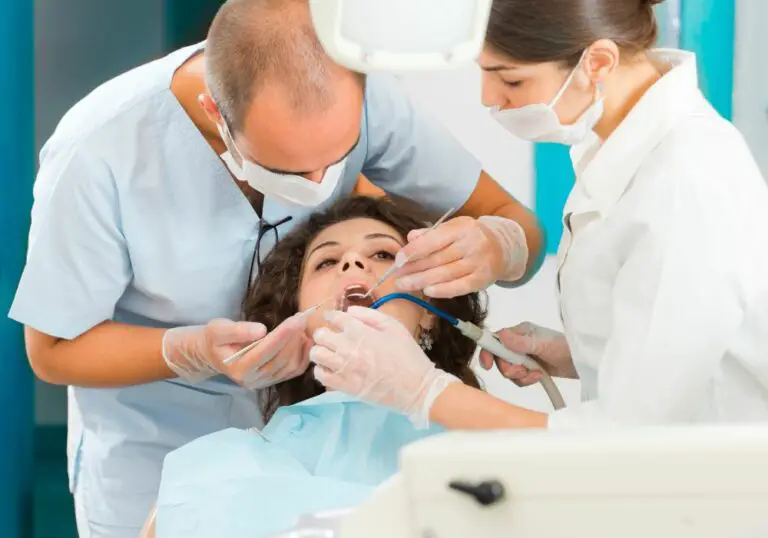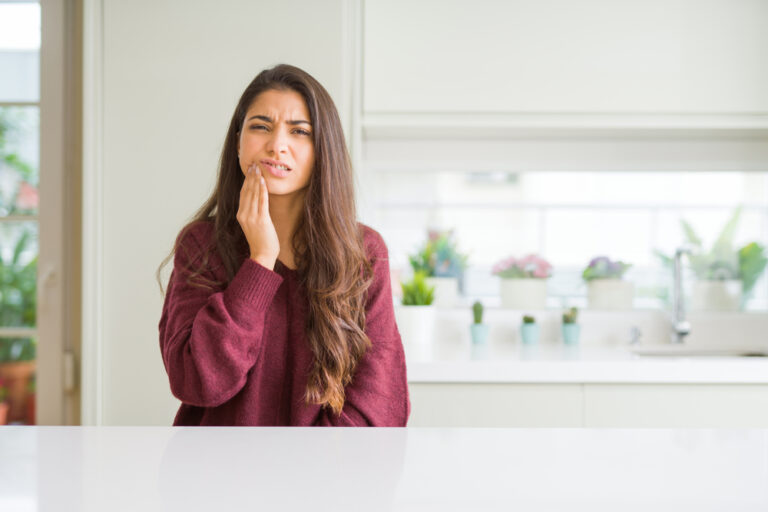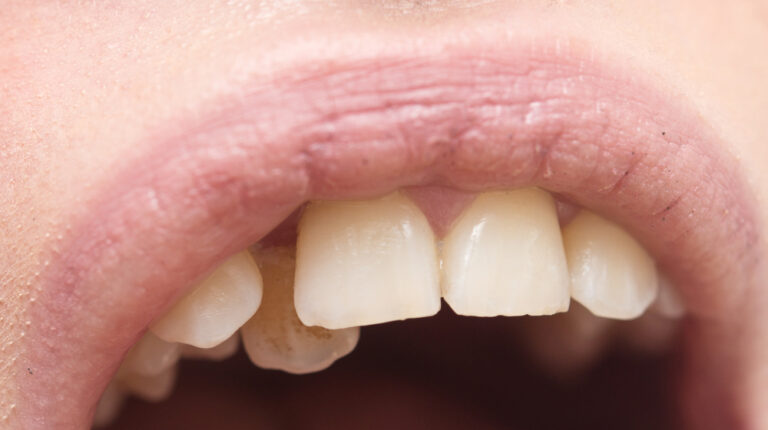Having braces is a big commitment, often spanning years until you achieve your perfect smile. You diligently wear rubber bands, avoid certain foods, and brush carefully around each bracket and wire. So why do your teeth not end up gleaming white like you expect? There are several factors that cause teeth staining and discoloration even with braces.
Causes of Teeth Staining with Braces
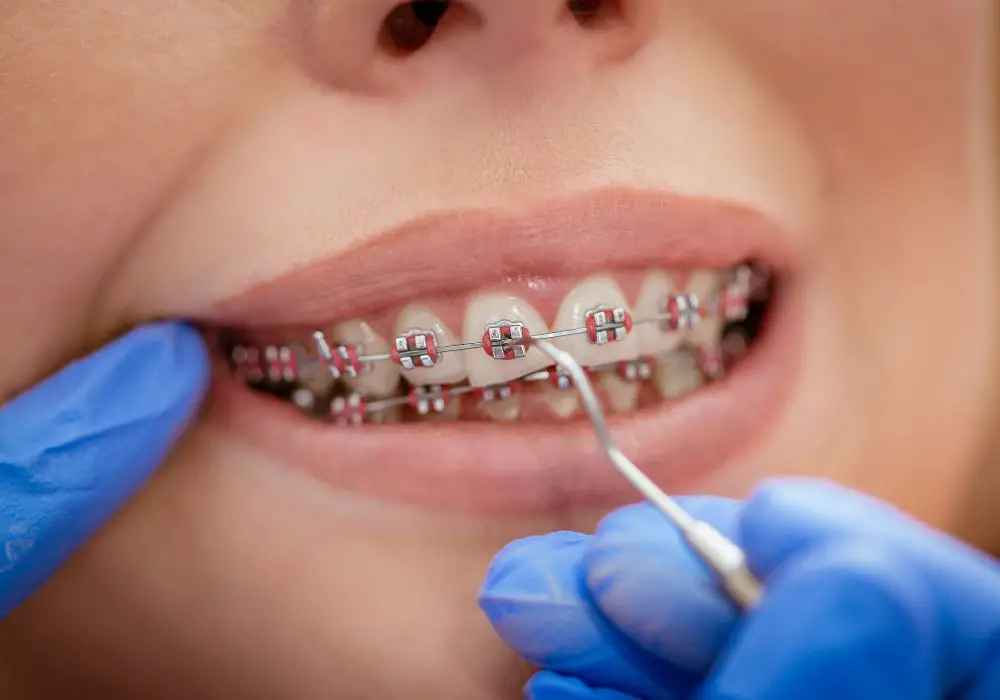
Braces alone do not whiten teeth, so without proper care, your teeth may pick up stains over the long treatment period.
Plaque buildup
Plaque is a film of bacteria and food debris that sticks to teeth. The brackets, bands, wires, and elastics of braces provide additional surfaces for plaque to accumulate on. If plaque is not adequately removed by brushing and flossing, the bacteria produce acids that erode tooth enamel and allow deeper penetration of stains.
Thorough cleaning around orthodontic appliances takes extra time and care. Plaque buildup left for months or years ultimately leads to gingivitis (inflamed gums), cavities, and ugly yellowing.
Poor cleaning around braces
Keeping teeth clean with braces is challenging but imperative. Fixed braces complicate oral hygiene because the metal attachments obstruct access for brushing and flossing. The nooks and crannies around brackets, under wires, and at bonded edges are prime areas for plaque to multiply if not cleaned properly.
Use special tools like interdental brushes, floss threaders, oral irrigators, and proxa-brushes to meticulously clean around orthodontic appliances. Electric toothbrushes with small brush heads also help remove debris. Take time to carefully brush and floss around every bracket. See your dentist every 3 months for professional cleanings to remove hardened calculus.
Food and Drink
The food and drinks you consume introduce pigments, acids, and sugars that erode and discolor teeth. Dark beverages like coffee, tea, soda, and red wine sneak into the microscopic pores of your enamel and cause extrinsic stains. Berries, tomato sauce, soy sauce, and other colorful foods also stick to brackets and discolor teeth over time.
Sugary treats feed the plaque bacteria and lead to decay. Acidic foods and drinks – like citrus, vinegar, carbonated beverages – directly erode tooth enamel making it more stain-prone. Limit consumption of staining and acidic foods. Thoroughly rinse your mouth with water after eating and drinking.
Smoking
Smoking or chewing tobacco products is absolutely detrimental for your oral health. The tar and nicotine lead to brownish-yellow staining on teeth and around orthodontic appliances. Smoking with braces greatly increases your risk of gum disease and tooth decay. The residues cling to brackets and are impossible to fully clean off. For cleaner, whiter teeth, quit smoking!
Medications & Supplements
Prescription drugs like tetracycline antibiotics can cause intrinsic grayish-brown discoloration if taken while teeth are still developing under the gums. Iron supplements or too much fluoride early in childhood (dental fluorosis) also create permanent intrinsic staining.
Review all medications you are taking to see if tooth darkening is a known side effect. Tell your doctor about any unexplained dental staining. Switch to alternative medication options if possible.
Grinding & Clenching
Aggressively grinding or clenching your teeth wears down the enamel. This abrasion makes teeth more prone to external staining and yellowing over time. Ask your orthodontist about wearing a mouthguard at night to protect your teeth if you suffer from bruxism.
Injury & Trauma
Injuries to teeth can cause internal and external discoloration. The impact disturbs minerals making teeth more porous. If tooth nerves die due to trauma, the tooth darkens from the inside out. Cracks and fractures also provide areas for stains to seep into the tooth layers. See your dentist promptly after any tooth injury to minimize long-term staining.
Dry Mouth
Insufficient saliva flow allows plaque and debris to accumulate on teeth. Staining foods and drinks also coat the enamel longer without saliva to naturally wash them away. Dry mouth is a common side effect of braces because brackets block salivary glands and make drinking uncomfortable.
Stay hydrated, chew sugar-free gum, and talk to your doctor if braces are causing chronic dry mouth and related staining issues. Consider prescription dry mouth products.
Why Aren’t Teeth White After Braces Removed?
After enduring braces for so long, patients expect gleaming white teeth when the appliances finally come off. But teeth are often still dull, yellowed or discolored after orthodontic treatment. Here’s why:
- Years of accumulated plaque and staining during braces are difficult to fully reverse. Stains penetrate deep within the enamel layers.
- Enamel scarring or demineralization from prolonged plaque acid attacks around brackets leave porous defects more prone to staining.
- Discoloration from certain foods, drinks, smoking, and medications over the years cannot be magically erased.
- Preexisting intrinsic stains from fluorosis, antibiotics or trauma remain unchanged.
- The contrast between your original off-white natural teeth and newly exposed enamel around brackets becomes more noticeable.
While braces align your teeth, they do not contain any bleaching agents to brighten discolored teeth. Attaining that desired white smile often requires additional whitening treatments after appliances are removed.
How to Keep Teeth White With Braces
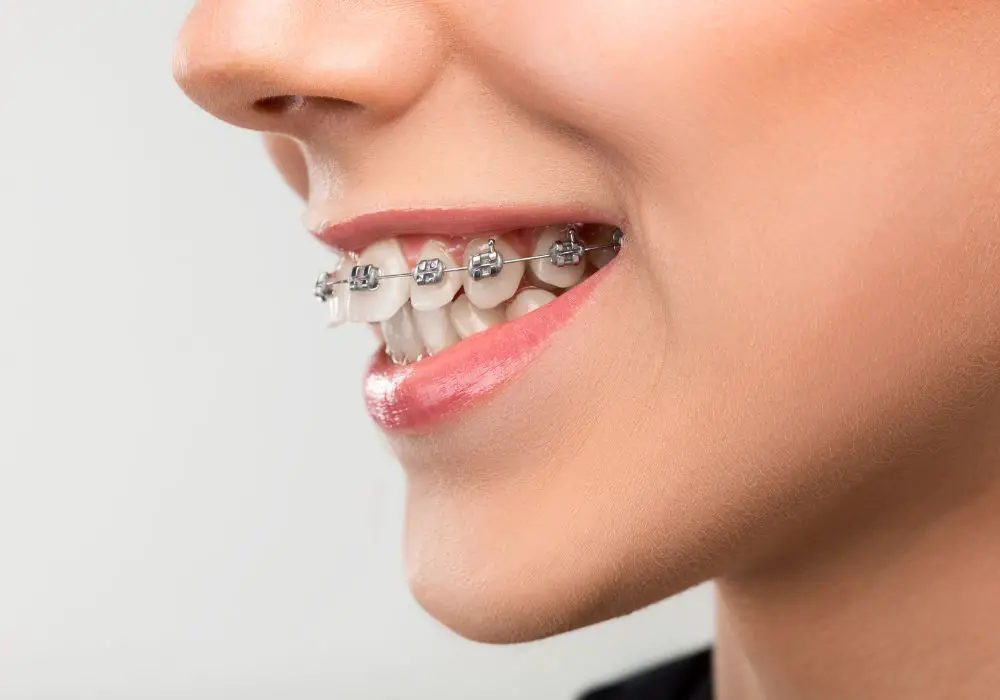
Although challenging, you can take proactive steps to minimize teeth staining during orthodontic treatment:
Impeccable cleaning
- Brush carefully after each meal – morning, night, and anytime food is consumed if possible.
- Use a sonic electric toothbrush to vibrate plaque off brackets.
- Choose an orthodontic toothbrush with slim head and super-soft bristles.
- Use special tools like floss threaders, interdental brushes, water flossers and proxy brushes to meticulously clean between teeth and around appliances.
- Rinse thoroughly with an ADA approved fluoride mouthwash to dislodge food debris.
- See your dentist every 3 months for professional cleaning and polishing while wearing braces.
Whitening toothpastes
Look for whitening toothpastes containing gentle abrasives or bleaching agents like silica, baking soda or hydrogen peroxide. Use as directed twice daily. Buy brands approved by the American Dental Association.
Eat & drink wisely
- Drink plenty of clear fluids, especially water. Stay hydrated.
- Limit consumption of staining beverages like coffee, tea, soda, sports drinks, and red wine.
- Avoid sugary candy and carbohydrate-rich processed snacks that feed plaque bacteria.
- Rinse mouth thoroughly with water after consuming staining foods and beverages.
Don’t smoke!
Avoid smoking cigarettes, e-cigarettes, cigars, pipes, and chewing tobacco. Nicotine and tar create yellow-brown stains and irritate gums.
Whitening treatments
Discuss professional whitening options with your orthodontist. Custom trays, strips, paint-on films, or in-office procedures may be prescribed for use during or after braces. Follow directions carefully.
Best Whitening Methods with Braces
If diligent oral hygiene is not keeping your teeth as pearly white as you’d like, consult your orthodontist about the best whitening approaches to use during treatment:
In-office whitening
A dentist applies a high-concentration hydrogen peroxide gel to your teeth and uses a special curing light to accelerate the bleaching action. Results are dramatic after just one 30-60 minute session. A custom mouthpiece ensures the gel contacts all enamel surfaces despite braces. There is minimal risk to orthodontic appliances with in-office whitening.
Dentist-prescribed trays
Your dentist takes molds of your teeth and provides custom-fitted plastic trays. You squeeze a carbamide or hydrogen peroxide gel into the trays and wear for 1-2 hours daily or while sleeping. Treatment lasts 1-2 weeks. Ensure trays fit snugly around orthodontic brackets.
Whitening strips
Strips coated with hydrogen peroxide effectively bleach teeth during the course of treatment. Look for products specially designed to curve around braces and whiten enamel surrounded by brackets. Use for 30 minutes 1-2 times daily over 2-4 week period.
Whitening toothpaste
Over-the-counter whitening toothpastes gradually lift stains from enamel with gentle abrasives or low concentrations of hydrogen peroxide or carbamide peroxide. Use twice daily in place of regular toothpaste. Buy ADA seal approved brands. May take a few weeks to notice results.
At-home gels
Your dentist may provide bleaching gels for use with boil-and-bite trays you mold at home. Apply the trays filled with gel for 1-2 hours each day. Refill trays every 2 weeks with fresh gel. Ensure proper fit around orthodontic brackets. Takes 1-2 months for full whitening.
Other whitening rinses
Swishing daily with an over-the-counter whitening mouthwash can help maintain brighter teeth between professional whitening treatments. Look for hydrogen peroxide formulas.
Whitening Before or After Braces?
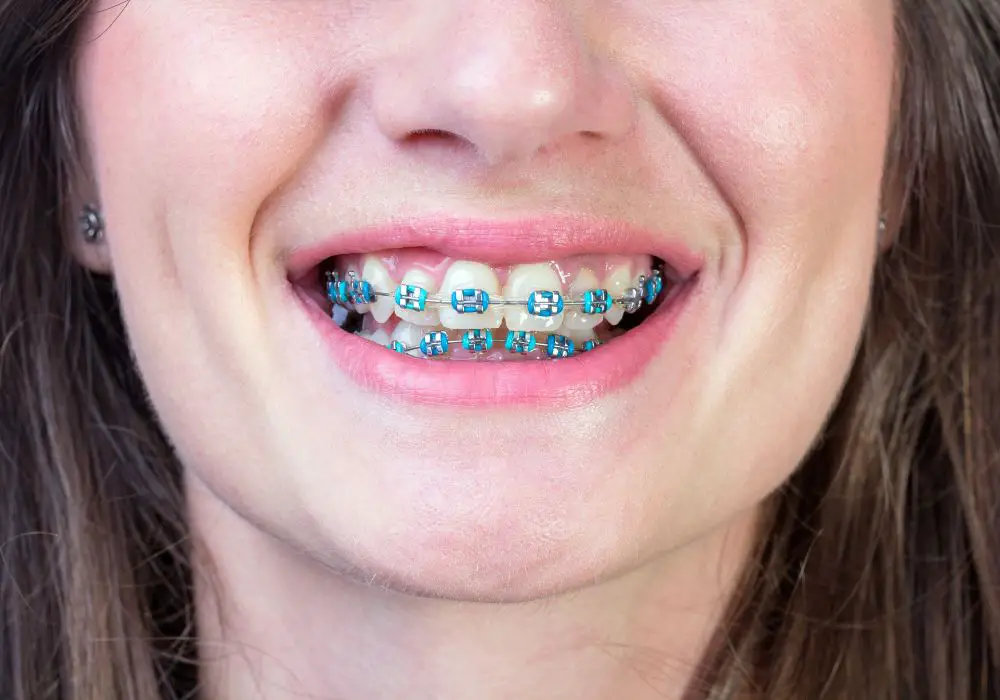
Trying to decide optimal timing to whiten your teeth? There are pros and cons to bleaching before or after orthodontic treatment.
Whitening Before Braces
Advantages:
- Start treatment with whiter teeth that better resist staining during braces period.
- Whitening results are easier to monitor without brackets obstructing view.
- May avoid major staining issues during braces by pre-whitening.
- Touch-ups after braces often suffice to maintain white smile.
Disadvantages:
- Must use custom trays rather than strips to accommodate future braces.
- Re-bonding brackets immediately after whitening increases risk of bond failure.
Whitening After Braces
Advantages:
- One major whitening treatment lightens teeth to desired shade.
- Can use any over-the-counter whitening strip or tray options.
- Newly exposed enamel whitens well after bracket removal.
Disadvantages:
- Must tolerate teeth staining throughout entire braces treatment.
- May require more intensive whitening after years of discoloration accumulates.
- Higher risk of tooth sensitivity immediately after braces removed.
There is no absolute right or wrong time to whiten. Get professional guidance from your family dentist and orthodontist. For moderately stained teeth, pre-whitening braces may be best. If your teeth are not too discolored, waiting until appliances are off may provide the most dramatic results.
Caring for Your White Smile Post-Braces
Congratulations – your braces are finally off and your teeth are gleaming! Follow these tips to maintain your bright white smile:
- Stick to your thorough oral hygiene routine of brushing and flossing twice a day to prevent new plaque accumulation and staining.
- Visit your dentist for cleanings and polishing every 6 months after orthodontic treatment.
- Use an ADA approved whitening toothpaste daily.
- Rinse periodically with an over-the-counter whitening mouthwash.
- Avoid habits that stain teeth – smoking, chewing tobacco, red wine consumption.
- Drink dark staining beverages like coffee, tea and soda in moderation. Don’t sip them all day long.
- Limit snacking, especially on sugary foods. Rinse mouth with water after eating.
- Hydrate with plenty of clear water throughout the day.
- Get touch-up whitening treatments as needed to maintain your new smile.
- Wear a mouthguard when playing contact sports to prevent dental trauma and staining.
By caring for your teeth properly, your brilliant smile can continue shining long after braces!
Common Questions about Whitening with Braces
Why did my teeth become yellow with braces?
Yellowing occurs because orthodontic appliances trap food debris and make plaque removal difficult. Years of accumulated plaque create unsightly yellowish discoloration. Staining foods and smoking also contribute to yellowish stains.
What is the fastest way to whiten teeth with braces?
In-office whitening performed by your dentist can dramatically brighten teeth in a single 30-60 minute session. A hydrogen peroxide gel is applied with a special light or laser to accelerate the bleaching. Custom trays are used with braces. Over 2-4 weeks, whitening strips or prescription trays with daily use also noticeably whiten teeth.
What foods should I avoid to keep teeth white with braces?
Avoid dark pigmented foods and beverages such as coffee, red wine, colas, soy sauce, berries, and tomato sauce. Limit sugary snacks that promote plaque. Rinse after consuming staining foods. Drink plenty of clear fluids like water.
Can whitening harm my braces?
Use caution with any bleaching agent and consult your orthodontist first. Hydrogen peroxide concentrations above 10% may damage orthodontic glue or appliances. In-office whitening involves specialized precautions to protect braces. Overall, whitening is safe for braces if done properly under dental supervision.
Is it better to whiten before or after braces?
Opinions differ on optimal timing. Whitening before braces means starting treatment with whiter teeth. But postponing whitening until after appliances are removed allows you to use strips easily and bleach newly exposed enamel. Talk to your orthodontist and dentist about the pros and cons.

